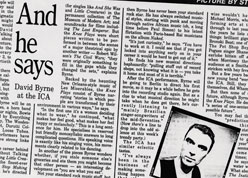ORIGINAL
PRESS CLIPPINGS

KNEE PLAYS A TALKING POINT
Wilson has been described as the most important force in contemporary American theatre. A portion of his 1986 Pulitzer Prize-winning work, The Civil Wars, began last night at the Concert Hall. Knee Plays will be performed tonight at 6 and 9 and tomorrow at 2pm and 8pm. Wilson collaborated with David Byrne of Talking Heads to produce Knee Plays, which is a sub-story woven through the tapestry of the international epic opera The Civil Wars: a tree is best measured when it is down. The Civil Wars was originally designed for the 1984 Los Angeles Olympics as part of the city's Olympic Arts Festival. Each knee play, or joint between acts, was to be performed during the massive scene changes of the opera. The 14-hour production was never performed in its entirety, although sections of the epic have been performed around the world. Knee Plays have proved popular on their own. The structure of the plays draws from conventions of Asian theatre, particularly those of Japanese Kabuki, Noh and Bunraku. Knee Plays choreographer Suzushi Hanayagi is one of Japan's foremost classical dancers. She has studied many forms of Japanese dance, including jiutamai, kabuki, noh and kyogen. Speaking from New York this week, Ms Hanayagi said The Civil Wars represented the civil wars of Japan, Germany, Holland, Italy, France and the United States. ""Robert wanted to make peace between the competing nations during the Olympics," she said. ""He doesn't care about the differences between Eastern and Western cultures — Knee Plays are to bring those cultures together. ""I joined Bob and David late. We had to begin with dance improvisation to work out the movements." Knee Plays consists of 12 acts, eight dancers and a music ensemble created by Byrne. A tree, a boat, a lion and a golden puppet are the focus of attention. The dancers serve the purpose of animating these objects and to locate and move stage properties. Wilson said recently: ""Each play serves as an introduction to the longer scene that follows. ""They also tell a story that can be seen separately from the complete production." Byrne said: ""The music had to be loud enough to drown out the noise of scene changes and be able to be set up and dismantled quickly. ""It couldn't involve heavy pianos coming off stage for instance," he said. The Les Misérables Brass Band, an American nine-piece ensemble, will perform Byrne's music.